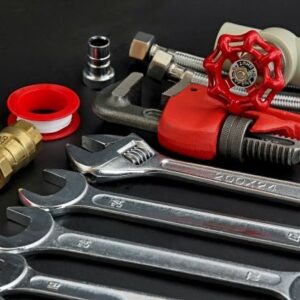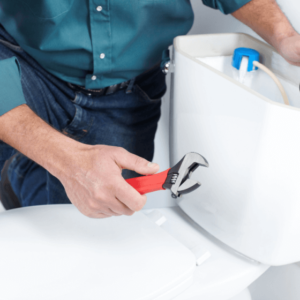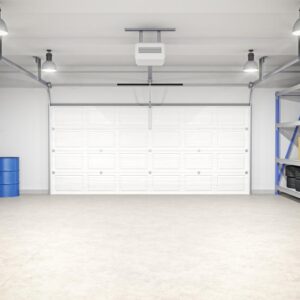Did you know you can create a basic handyman tool kit at home? With several basic plumbing tools, you can skip unnecessary calls to a plumber. While some tasks still require professional help, many are simple enough to do on your own. This guide will show you what you need to make a plumbing repair kit for different fixtures.
What Is a Plumbing Equipment Tool Kit?
A DIY plumbing tool kit is a set of tools and equipment you’ll need for most minor plumbing issues. You’ll learn more about the specific tools included in an upcoming section. Keep in mind that you may still need to buy parts as needed. For instance, if you discover you need a new toilet flapper, you’ll need to buy one. Your tool kit will enable you to install many parts yourself, though.
What Would I Need a Plumbing Repair Kit For?
You may be wondering why you should keep the tools on hand and not buy them as needed. The main reason is that plumbing problems seem to occur at the worst times. They can happen on weekends, during snowstorms, or in the middle of the night. Also, you won’t have to worry about rushing to the store, only to discover that what you need is out of stock. These are just a few of many potential problems you’ll need plumbing tools for:
- Minor toilet issues
- Dripping faucet
- Toilet clogs
- Leaky pipes
- Sink not draining
- Low water pressure
What Are the Basic Plumbing Tools? The Plumbing Tools List
A complete plumber’s tool kit includes all the most important tools. Your plumbing tools should be ready and easy to grab whenever you need them. The following points cover some essential tools and why they’re important to include in plumbing repair kits.
Hacksaw
This saw is a versatile tool. As its name implies, it can hack its way through many things. You can use it to cut through screws, metal pipes, plastic pipes, and bolts. Keep it tense when you need to make tougher cuts. When you buy a hacksaw, it’s wise to purchase a few extra blades since the original ones will eventually wear out.
Tube and Plastic Pipe Cutters
These are another valuable addition to your tool kit. They are great if you need to cut through plastic. If you’re not anticipating using them very often, you may be fine with just a hacksaw. When you need to cut copper pipe, be sure to buy both standard and close-quarter tubing cutters.
Propane Torch
If you’re comfortable sweating copper pipe and fittings, you’ll need this tool. Some types of torches require manual lighting, which can be a hassle in some situations. If you appreciate convenience, spending a little extra for a self-igniting head is worth it. Be sure to have a fire-resistant cloth ready to cover any nearby surfaces whenever you use the torch.
Plastic-Toothed Drain Snake
You can find this simple device for a low price. It’s flexible and has jagged teeth along its sides. If you have a clogged bathtub or sink, that’s a great tool to start with. It pulls up shallower hair and soap scum clumps easily.
Hand Auger
This circular tool lets you drive a cable far into a drain. It’s useful for breaking up and clearing out deep clogs. There are several types and styles of hand augers. You can choose the size and style that suits your preference. A basic auger or drain snake works for most small sinks or basins. For deep clogs, look for augers that can reach longer distances.
Closet Auger
This manual hand tool helps clear toilet clogs and is essential for every toilet drain kit. It has a long and tough steel cable that can break apart difficult clogs.
Plungers
In addition to an auger or drain snake, plungers are essential for any plumbing tool kit. You’ll need two different types for two potential problem sources. A flange or toilet plunger is essential for your toilet plumbing kit. A cupped plunger is for sink drains.
Tongue-and-Groove Pliers
Every plumber’s toolbox has tongue-and-groove pliers. They are great for twisting, holding, pulling, and grabbing something. When you buy these pliers, it helps to buy two important sizes. Choose 10-inch pliers and 12-inch pliers for your DIY plumbing tool kit.
Metal File
Whenever you cut through metal, you’ll need to sand it. A metal file will help smooth rough edges and remove burrs. For better results, buy a half-round file and a rat-tail file to tackle common projects.
Press Fitting Systems
These are optional items. If you plan to handle a few larger pipe repair or installation tasks on your own, add them to your list. They help to fit and connect pipes securely, which is an essential step. If you don’t want to deal with soldering or welding pipes, press fitting systems are great.
Borescope Camera
This item is also optional. It’s a small camera on a long and flexible cable. You can use it to see clogs or interior pipe surfaces to inspect their condition.
Types of Pipe Adhesives
You’ll also need to stock up on some pipe adhesives. Joint compound with thread-sealing tape is a common combination. Another combination is PVC primer and cement. These are the items to buy.
Joint Compound
Before you apply thread tape, the joint compound goes on first. It fills thread spaces to prevent leaks.
Thread-Sealing Tape
You may also hear people call this plumber’s tape. It is used for patching or preventing threaded joint connection leaks in piping. The best plumber’s tape resists both low and high temperatures. Also, it’s stretchy and flexible to allow a snug fit.
PVC Primer
Most PVC primers come with special brushes for application. The goal is to apply the primer to the inside and outside of a fitting’s end. There shouldn’t be any clumps.
PVC Cement
PVC cement goes on over primer immediately after you apply it. This means you shouldn’t wait for the primer to dry. Always apply the cement generously over the same areas where you apply primer.
Types of Wrenches
There are several types of wrenches you’ll need for various projects. These are the key wrenches to buy for your kit.
Adjustable Wrench
For supply lines, compression fittings, and several other parts with hex nuts, you’ll need this wrench. It helps to have two sizes: 6-inch and 10-inch wrenches are good sizes to start with. Pick sturdy wrenches that won’t slip under torque.
Pipe Wrench
A pipe wrench helps turn rounded fittings and soft iron nuts or pipes. The jaw is adjustable and locks in the frame. For easier work, buy two of these. You’ll need one for holding and one for turning. When you use them, be sure to have some cloth handy to put over the serrated teeth. If you don’t do that, the teeth can damage a fixture’s finish or head.
Basin Wrench
This is one of the most essential plumbing tools. You’ll need this wrench for adjusting sink faucet nuts and some other tasks. With its swiveling jaw and long shaft, it can easily reach narrow spaces.
How to Assemble Your Own Sink Repair Kit
Perhaps you want to fix a leaky faucet or install a new faucet. Sink issues are the most common DIY plumbing projects. These are some of the tools from the list you may need:
- Basin wrench
- Plastic drain snake
- Hand auger
- Sink plunger
- Pliers
You may also need some specific sink plumbing materials or parts for your project. For example, if you need a replacement nut or bolt, be sure to choose the right size for your project.
Now that you know the plumbing equipment you need for DIY repairs, you can start building your kit. Find everything you need for plumbing kits and repairs at your nearest True Value store.












